List of Authors
>>About this blog
Recent blog post
|
[CAM]
June 27, 2015 16:00
To learn about the history of Tokyo since the Meiji era, especially Chuo-ku (Nihonbashi-ku and Kyobashi-ku), I think that Saiden Stecker's "Tokyo Shitamachi Yamanote (LOW CITY, HIGH CITY)" and "Starting Tokyo (TOKYO RISING)" are good literature (In English, both are combined and published in "Tokyo from Edo to Showa 1867 Paper" is a book. "I like it" is not just a tasteless and dry history book, but a book full of clear subjects and love for the authors of Edo and Tokyo.
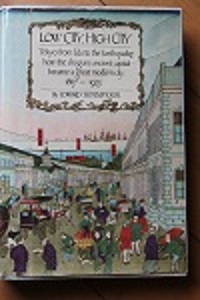 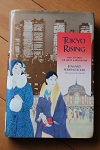
In particular, "Tokyo Shimomachi Yamanote" is a book filled with Saiden Stecker's love for "Shitamachi" (mainly Nihonbashi Ward and Former Kyobashi Ward). Only the authors who translated the works of The Tale of Genji and Tanizaki in English have a deep and concise description that is far beyond ordinary Japanese. Regarding the previous work, the author himself stated as follows in the brush of "Standing Tokyo".
>(The previous book) It was a kind of honka to the flow of downtown, which used to be the center of Edo culture, eventually ceased to be the center in any sense. (03)
The book is elegiac, its emphasis on the part of the city which was ceasing to be any sort of center at all.
And in the previous book, it is as follows.
>Of course, the death of the old one is deeply intertwined with the emergence of the new one, and is not so clearly separated. However, the fate that the tradition of Edo followed is solely related to downtown, so things that are not related to downtown must naturally appear in this book. ・... I guess the history of Tokyo can distinguish between what happened because it was the capital and what it experienced as a city. And what I wanted to write was the history that Tokyo had gone through as a town. (07)
The departure of the old and the emergence of the new are inextricably entwined, of course. Yet, because the story of what happened to Edo is so much the story of the Low City, matters in which it was not interested do not figure much. ・・・・・
A distinction may be made between what occurred in the city because it was the capital, and what occurred because it was a city.
[Koedo Itabashi]
June 25, 2015 16:00
"Come here, come here, and turn this way."
With his father's hand, the boy walks through the "Chinowa" on the approach to the shrine.
I really liked the tattata and the movement around the figure 8.
Make bamboo and hang a ring that bundles chigaya.
A circle set like an entrance to a different world and a ∞ character that shows infinity.
I feel that the power is drawn out, which cannot be expressed in words.
There is a song about the effect of Chinowa.
"The person who exorcises Natsukoshi in Minazuki is going to extend the life of Chitose."
It is a prayer for longevity.
There is also a practice of passing through the circle while singing this waka.
In the bulletin board of the Neighborhood Association, there was a sentence of the reception of Katashiro.
On the eve of June, he transfers his injuries to a paper doll, flows it to the river, and cleans it.
Is it a ritual of regeneration?
This yeny Chinowa. Actually, there is a theory that it is the prototype of the New Year's "Shinto straw festoon".
If you loosen the ring, it will be a single rope.
A rope that shows a clean place.
The figure that turns round, turns into a line, and is illusionless, is a blue general due to its thickness and color.
It is a relatively familiar "Nebi-kun" that lives widely in wilderness in Japan.
It is not uncommon for Japanese gods to borrow snakes.
The guardian angel of rivers and swamps, the Lord, the rain, the thirst, and the rich fruit.
It seems to be compatible with oval and treasure ball.
After all, the appearance of regenerating and growing while molting is very mysterious.
I feel the power that can't be measured.
The power to cross the field, cross the river, move over the rough seas, and repeat regeneration.
Old people have repeated "women's emotions" like "Anchin Kiyohime".
It's a rainy season.
On a sunny day, choose a new power at the nearby shrine, Chinowa Gourmet.
Let's come.
Are you on my way?
It's Tsukiji's Namishi Inari Shrine!
[CAM]
June 25, 2015 09:00
A book written by a landlady (Kie Shiga), who opened a small restaurant on his own from a place where he had no experience in water sales and developed it to be called a famous restaurant ("Ningyocho Saketei Kikuya Prosperity Report" Soshisha; 2001).
Shiga initially wanted to open a store along the Metro Hibiya Line (around 1975), and considered several station squares, but said, `` If the flow of people is in a certain direction, it is difficult to welcome the second turn customer. It's difficult to meet, and the town is perfect to return from the station, where the puppets come out at the station, where the puppets come out at once. It would have been a good point of view for an amateur.
However, Ningyocho used to be one of the best places in Tokyo, but now it is a little difficult to classify it as a "platter".
Saiden Stecker stated in "Rising Tokyo (Rising Tokyo)" (original book 1990) as follows (translated by Tetsuo Anzai).
>The Taisho era was a period of great change anyway. The venue will also change significantly. There is a record of investigating the prime location of Tokyo in 1929, but ...
The names listed in this survey are Ginza, Shinjuku, Ueno, Asakusa, Shibuya, Ningyocho and Kagurazaka, but now there are no people who list Ningyocho and Kagurazaka as representative places in Tokyo.
・・・・・・・
Ningyo-cho was very lively during the Meiji era, but has continued to decline after the earthquake. Most of the old Nihonbashi Ward was once the center of Edo townspeople's culture that both themselves and others recognized, but they all followed the same fate. Even in Ningyocho, it is a great place to explore the features of the old downtown, but in terms of gathering people, it is not comparable to that of Shinjuku. (40)
Ningyocho was lively in Meiji and has been in decline since the earthquake. So has most of the old Nihombashi Ward, the recognized center of mercantile Edo. Ningyocho is as good a place as any to go in search of the mood and flavor of the old Low City, but it is not the smallest competition with a place like Shinjyuku in the matter of drawing crowds. (41)
>The most popular vaudeville in Tokyo was Suehirotei, which was located in Ningyocho, Nihonbashi, but the number of customers gradually decreased, and it will be closed in 1970. Ningyocho still retains some of the remnants of Nihonbashi in the past, but it is no longer a prime place for the past. Unlike the nearby Meijiza, Suehirotei escaped the war. Immediately after the war, it looked as if it was trying to bring back the bustle of the past by beckon the town of Nihonbashi over the entire burning field. (153)
The most popular Yose theater in the city was for a time near the Sumida River in the Ningyocho district of Nihombashi. It closed, for want of a clientele, in 1970. Ningyocho, in which something of old Nihombashi yet survives, is not the bustling place it once was.
It escaped the bombings, though the Meijiza, to the east, did not. In the years just after the war it seemed to beckon across the waters to western Nihombashi, where big business and finance resided, as if asking it to come home again.
In addition, Shiga says about the neighborhood of Ningyocho, `` As a place name, if you look at the old map, the names of former Osakacho, Sakaimachi, and the Kansai area are listed, and there is a textile wholesaler in Horidome. Considering that, it is the center of Edo, but I feel that the smell of Kansai is strong. " I agree with you. I felt that way shortly after walking through Nihonbashi.
[Minori]
June 24, 2015 18:00
Nice to meet you, this is Minori.
This year is the main festival of Tsukuda and Sumiyoshi-jinja Shirine.
The fifth generation Kawayanagi Mizutani Ryotei stone monument, related to Tsukuda, is located on the grounds of Sumiyoshi-jinja Shirine.
I would like to introduce this Sumiyoshi-jinja Shirine and the fifth generation Kawayanagi Mizutani Ryotei stone monument.
stone monument was built in 1966 by the people of Tsukuda.
 Sumiyoshi-jinja Shirine (1-1-14 Tsukuda, Chuo-ku) Sumiyoshi-jinja Shirine (1-1-14 Tsukuda, Chuo-ku)
<enshrined deity> Bottom Tsutsuno's life Nakatsuno's life, Tsutsuno's life (Mikami Sumiyoshi)
Breathing Princess Himemei Empress Jingu
Tosho's life (Azuma Terumioya no Mikoto) Ieyasu Tokugawa
<auxiliary shrine> Ryu Shrine, Epidemi Shrine, Pox Shrine, Irifune Shrine, Funatama Shrine, Inari Shrine
(From the bulletin board of Sumiyoshi-jinja Shirine)
<History>
Fishermen in Tsukuda Village in Settsu (Tsukudada, Nishiyodogawa-ku, Osaka) visited Sumiyoshi-jinja Shirine and other places when Ieyasu Tokugawa visited Japan.
There has been a connection since passing the Kanzakigawa River, and was greeted by Edo around 1612 (1612).
At first, he lived in the warehouse of Mamoru Ando in Koamicho, where he recommended his hometown Sumiyoshi guardian god, and later.
The land of Tsukuda Island was issued and created, and in 1646, shrine hall was built at the current location of the island and relocated.
In 1699, it was incorporated into a historic site (shrines and temples, which was built before 1631, 1631).
Shinto priesthood was inherited by Tsumori (later renamed Hiraoka). Our company is not only the guardian god on Tsukuda Island, but also the
Due to the fact that the front of the company was Minato of the ships of various countries, like the gunshot Inari Shrine on the opposite bank, the religion of shipping companies was strong.
He was also believed by related wholesalers. In 1705 (1705), a friend of Edo descent sake ruler formed Sumiyoshi-ko.
Every year on New Year's Day and September, the dedication of Garden Kagura was decided, and in 1843 (1843), Kobunamachi Gumi of a bonito wholesaler
It is also a sign that every April, we decided to dedicate Kagura of bonito fishing.
("Chuo-ku Cultural Properties (4)" Tangible Folk Cultural Properties-Religion-Published by Chuo-ku Board of Education)
 Gosei Kawayanagi Mizutani Ryotei stone monument (1-1-14 Tsukuda, Chuo-ku) Gosei Kawayanagi Mizutani Ryotei stone monument (1-1-14 Tsukuda, Chuo-ku)
Mizutani Ryotei (1787-1858) was born in Minami Kayabacho, "now Nihonbashikayabacho".
It is reported that he lost his father when he was young and was received next to Tsukudashima fishermen Taihei, and served as village headman on Tsukuda Island.
(From the bulletin board of the Chuo-ku Board of Education in the precincts of Sumiyoshi-jinja Shirine)
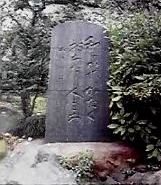 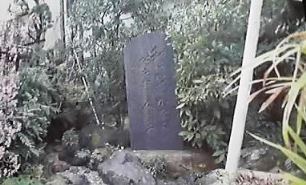
[Kra-san]
June 24, 2015 09:00
At Koami Shrine, a large Chinowa made of a bundle of kaya is displayed from the 20th, and it is installed at the torii gate until June 30th, when the "Natsukoshi great exorcism" is held.
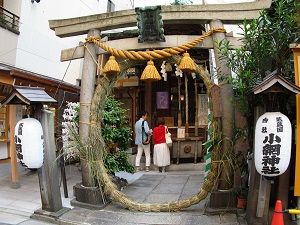
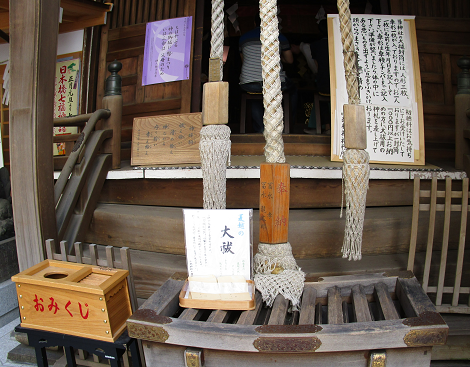
great exorcism is a Shinto ritual that has been handed down since ancient times, and is a traditional ritual that prays twice a year (June and November) in front of God for purifying sins and filth, purification of the mind, and reviving the soul. Also, if you put a doll (Hitogata) to the shrine with the first ho fee, you can pray in the great exorcism style.
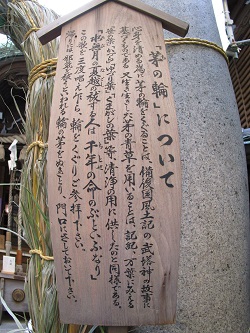
I go through "Chinowa" to cleanse my mind and body, but this is based on thetopographical record of Bingo. At the time of this passing through Chinowa, "The person who purifies Natsukoshi of Minazuki is the life of a thousand years." On the way back, he will remove the ring kaya, which is said to exorcise evil, and leave it at the entrance.
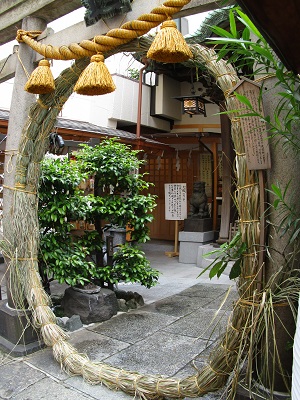
I want to cleanse my mind and body and overcome the summer with my feelings.
[CAM]
June 22, 2015 10:00
Ginza is said to have been a favorite city for director Yasujiro Ozu, so it has often appeared in his work.
In "late spring" (1949), Setsuko Hara goes shopping in Ginza.
In "Sisters of Sokata" (1950), Kinuyo Tanaka works at a bar in Nishi Ginza.
In "Wheat Autumn" (1951), Chishu Ryu and Kuniko Miyake's brothers and sisters and Setsuko Hara eat tempura at a small restaurant in Ginza.
In "Taste of Ochazuke" (1952), Keiko Tsushima goes to see a movie after shopping in Ginza. Also, I was invited by Koji Tsuruta to Ginza Road I go to a ramen shop in the back of the ground.
In "Tokyo Monogatari" (1953), "Hato Bus", which Setsuko Hara rides with Chishu Ryu and Chieko Higashiyama, passes through Ginza and Matsuya Depper.
There is a scene that guides you to the rooftop of the remote.
Tsukishima appears in "Women in the Wind" (1948).
It is based on the theme of returning to the battlefield shortly after the war, and is a very serious and dark story for Ozu's work. Ozu himself is said to be a work that he did not always like. The wife, who plays Kinuyo Tanaka, left herself to another man only once to cover her child's illness while her husband had not returned. Then, the husband who returned immediately after hearing the confession from his wife and visiting the place (Tsukishima), but Inuhiko Yomota infers quite a bit about the place ("Tsukishima Monogatari Again" 2007). According to him, behind Tsukishima Daini Elementary School, there are currently an antique furniture store using an empty warehouse, a rehearsal hall for theaters, and a multi-purpose building, and it seems that there is a metropolitan house behind it. And it is said that this area is the only place in Tsukishima that was strongly influenced by post-war customs. There are scenes where a husband played by Shuji Sano sits on the riverbank while looking at Kachidokibashi on his right, but now I can't find any remnants.
Most of Ozu's works can be viewed on DVD except for some of the silent ones. Looking at postwar works over time, you can feel the revival of Japan after the war.
|
Links
|







